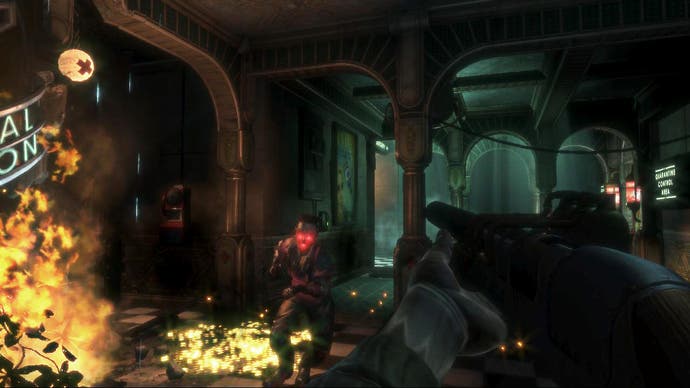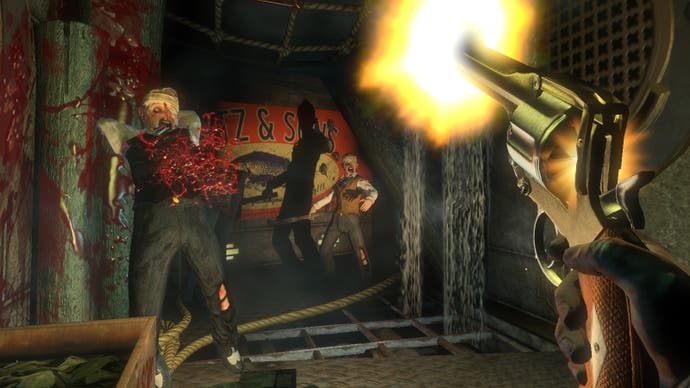BioShock
Harvest soon.
As you begin pacing around the environment, you immediately appreciate the staggering attention to detail hinted at in previous demos and trailers. The post-lapsarian devastation wrought by mankind on its own earthly paradise is captured brilliantly by the battered, punctured shell of Rapture. Water is seeping in everywhere, as reality inexorably bursts into this hermetic bubble of life; fish flap wildly on the floor, gasping for air; vast streaks of blood paint the floors and walls, hinting at the violence that lurks within; discarded, bloodstained placards tell a story of broken dreams - "Rapture's Dead"; "Ryan doesn't own us".
Atlus urges us to search the still-warm corpse of the victim. We pull out an Eve hypo and inject it into our arm. The effects are immediate and overwhelming, screaming as our body spasms uncontrollably and bolts of electricity flare from our veins. We've just had our genetic code rewritten, Atlus helpfully informs us. The Plasmid we just mainlined gives us our first taste of the power of Adam: Nanobolt, the ability to fire bolts of energy from our hand.
Eve, Adam's counterpart, is the serum that carries the Plasmids, providers of all the super-human abilities we'll evolve during the game. As well as a regular health bar, there's also an Eve meter, which depletes when abilities are used, and can be replenished via pick-ups and items purchased from vending machines found throughout Rapture.
You can also pick up a series of Gene Tonics, either Physical, Engineering or Combat, which provide more limited boosts to various abilities, as the names suggest.
Bioshock employs basic first-person controls with a few additions. The left bumper equips Plasmids, and the D-pad can be used to cycle between various types of ammo, for instance.

In the opening section of the game your traditional attacking options are limited to a couple of guns. But ammo is incredibly scarce, and faced with hordes of rampaging Splicers, we frequently found ourself reduced to smacking the freaks across the skull with a wrench.
You'll also have your genetic powers, of course, but again, these are strictly rationed and it's vital that you make every strike, every last bullet count, as you never know where the next ammo or Eve pick is going to be. And since the Splicers apparently spawn randomly, an itchy trigger finger will put you in some pretty deep water, if you'll forgive the pun.
This deliberate stinginess with ammo is clearly designed to ramp up the tension and stop deathmatch nutcases from storming around raining bullets in every direction. Tense, yes, but also occasionally frustrating as we're reduced to the wrench, without a sniff of ammo, against some pretty substantial odds. But then, your correspondent is probably just an FPS pussy. And the sense of achievement is palpable when a particularly gruelling section is cleared.
One of Bioshock's major selling points is the promise of attacking options limited only by the player's imagination. Levine has waxed lyrical about 'AI ecology' and the freedom of expression afforded by a truly interactive environment.

Before our playtest, the point was hammered home by a demonstration of a later section of the game approached in three distinctive, increasingly experimental ways. Despite the clear brief, the demoer was still required frantically to improvise because of the random distribution of foes.
In practice, and even at such an early stage of the adventure, we're delighted to report that Levine is as good as his word. (Frankly, there'd be riots otherwise). Splicers come as single tormentors and in battalions. And you never know where these ugly bastards are going to spring from. I lost count of the number of times I flinched in my seat, reeling from a surprise assault, stumbling around to get bearings, steady the weapon of choice and fight back.
When weapons are coupled with Plasmids, your options multiply dramatically. Nanobolt can temporarily stun Splicers, giving vital extra seconds for you to unload a couple of rounds to the face, or deal with any additional fiends. Back a few Splicers into standing water, and a quick blast fries them spectacularly where they stand, a fabulously orgy of electric death.
The Plasmid that produces flames works in the same way with oil. And Splicers set ablaze are just as likely to use water literally to save their own skin. Telekenisis is the final power available in our playtest, and if you've watched the trailers released so far you'll be acutely aware of its potential. The wasted art deco disaster zone or Rapture provides the perfect projectile playground, and a lifeline when ammo has been exhausted.

And then there's hacking. Machines can prove a deadly foe - stumble before the cold glare of a security camera, and hovering sentry robots are promptly dispatched to spray your brains up a wall.
Yet these can be adapted as an extra dimension to your arsenal through hacking. So a successfully hacked sentry suddenly becomes a Splicer-blasting scout for you, or can create the perfect diversion while you slip through an area unharmed. The penny finally drops for this formerly frustrated FPS pussy.
Vending machines are also susceptible, a successful hack revealing more items and cheaper prices. But while the results of hacking are a multitude of approaches, the actually act of hacking is something of a let down.
The game switches to a mini-game in which pipe sections must be rearranged in a grid to facilitate the flow of liquid. It's reminiscent of The Assembly Line's Amiga puzzler Pipe Mania; and, more recently, the bomb defusing mini-games in Spider-Man 3.
In the context of Bioshock, these serve to, for this writer at least, puncture the illusion and atmosphere, dragging you out of a tense, seamless, captivating gameworld to complete an arbitrary logic puzzle. None of which is particularly strenuous or taxing in the first section of the game; though we'd expect them to increase in complexity at the very least as the game progresses.







